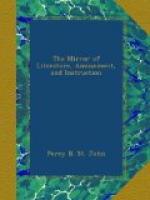The milk intended for distillation is only allowed to remain twenty-four hours, in summer, in the skin-bottles to sour; but in winter, and in cold weather, it may be left two or three days to be rendered fit for distillation. The cream is not taken off; on the contrary, the milk is agitated very strongly, from time to time, with the stick, and the butter which forms of itself on the milk, or even on the common Tchigan, is removed and employed for other uses.
Notwithstanding the numerous testimonies on the subject, and the daily experience, not of the nomadic tribes alone, but also of all the Russians, many people in Europe cannot conceive how a spirituous and inebriating liquor could be obtained from milk. But it cannot be supposed that those travellers who have repeatedly seen these tribes distil their brandy from milk, without adding the least vegetable matter to the original liquid, and then, in their unbridled passion for debauch, drink until they stagger and fall, have said so merely to impose upon the public. Nor can it be objected that the weakness of their head renders them liable to be easily inebriated by the vapours of the milk, for the Kalmucks can take very large quantities of grain brandy without losing the use of their legs; and there are Russians, who, although professedly great drinkers, are sooner inebriated than the Kalmucks by milk-brandy, and often even by the sour milk of mares, and yet are extremely fond of this kind of drink. I am aware that strangers have in vain tried to make milk-brandy. I shall even confess that I had a trial made under my own eyes, at Selenginsk, by Kalmucks, and was so unsuccessful, that I only obtained a watery fluid which had the smell of sour milk; but the reason of this was, that two clean vessels had been used. On the contrary, whenever I allowed these people to use their own vessels, abundant alcoholic vapours were procured. It is, therefore, an important point to determine, by means of vessels impregnated by long use with a strong smell, and the remains of sour milk, that sudden souring which developes a spirituous principle. This fermentation of a rare species, and entirely sui generis, can only be brought to the desired perfection by frequent repetition of the process, just as, according to Russel,[5] the thick milk (leban), which the Arabs habitually use for making cheese, can only be obtained by producing the coagulation of the fresh milk by means of a milk previously curdled, or, in other words, by the cohobation many times repeated of curdled milk.
After describing the process of distillation, Pallas remarks, if the brandy is made from cows’ milk, what is obtained is equal to the thirtieth, or at most to the twenty-fifth part of the mass; but when from mares’ milk, it equals the fifteenth part. The new fluid is pale and watery, and does not inflame; but it keeps without spoiling, in glass bottles, like weak corn-brandy. The rich Kalmucks render it




